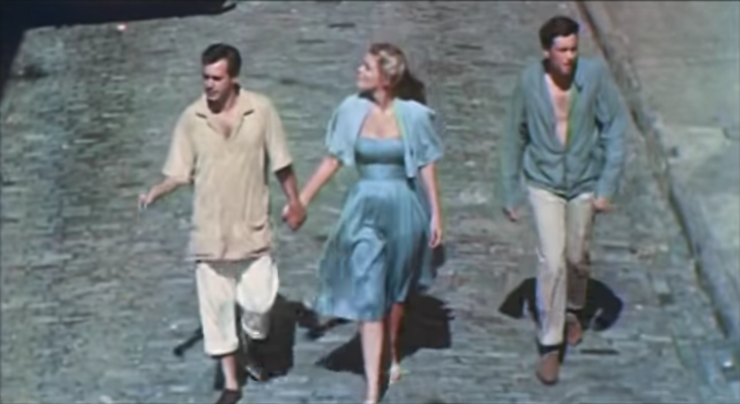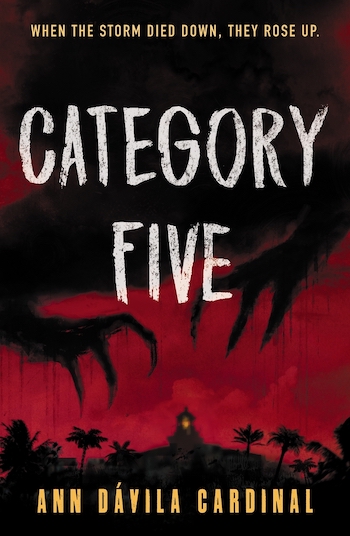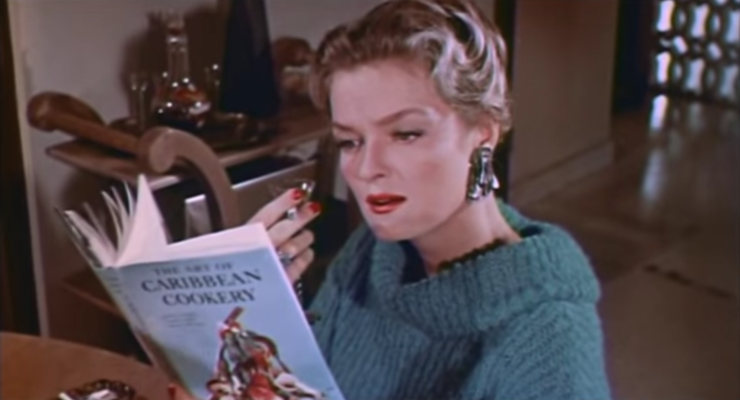When I learned of exploitation film director Roger Corman’s Last Woman on Earth, part of his “Puerto Rico trilogy” (a trio of films shot in Puerto Rico in 1960) I knew I had to watch it. A post-apocalyptic film from The Pope of Pop Cinema set in 1960s Puerto Rico? Yes please! I wanted to see if he captured the island I remember from my childhood. But then I thought: why not watch it when we were actually in Puerto Rico? To that end, I packed the DVD with the overly sexualized image from the original poster on the front securely in my luggage. On movie night my husband and I went all out, popping corn, projecting the film on the white wall of my uncle Esteban’s beach condo as if we were at a drive-in.
It was quite the experience watching this science fiction movie shot not far from where we sat, with the sound of the ocean in stereo from out the windows and from the computer’s speakers. But it wasn’t until later that the poignancy of watching this particular film at this point in history hit us.
Corman is pretty honest about the fact that he chose to shoot this film in Puerto Rico because of the tax breaks offered by Operation Bootstrap, a project implemented after WWII to try and modernize the island’s economy. In other words: it was cheap. Each of the three films in the collection had a two-week shooting schedule (!) and Last Woman on Earth was the only one shot in color (an expense Corman felt justified given the bright, Caribbean setting). The film opens at a cockfight, stereotypical and brutal but at least authentically Puerto Rican, particularly in the 1960s. A businessman, Harold Gurn (played by Antony Carbone) and his beautiful, lush wife, Evelyn (played by Betsy Jones-Moreland), meet up with Harold’s lawyer, Martin Joyce (Robert Towne) to discuss the latest in a string of legal troubles. As the trio heads to the Caribe Hilton, I perked up. My grandfather used to take us to that hotel for Sunday brunch in the late 1960s, and the mid-century fabulousness I remember so well was on full display in the film. In those days it was the place to see and be seen on the island, expensive and trendy, the very birthplace of the piña colada. In the film they walked through the open-air lobby with caged bright parrots, Danish furniture, even the fabulous script logo. It felt like time travel, and I was all in.
The trio go out snorkeling, and while they’re underwater something happens, and they return to find the Puerto Rican boat captain dead. Martin speculates that the oxygen had been sucked from the air while they were underwater, quite a reach from so little evidence, particularly for a lawyer. They swim to shore, and as they stumble through the “jungle” they discover they can now breathe, and conclude it is because they are surrounded with lush plant life which gives off oxygen (an environmental message, perhaps?). As they make their way through the trees, Harold finds a dead toucan on the ground. A toucan. Not only are there no toucans in the wilds of Puerto Rico, the bird he picks up is stiff as a board as he waves it at the other two (I spit soda out my nose). When they get back to “town” (Old San Juan is a city, thank you very much) they find everyone dead. Shots of empty streets of the old city with a Puerto Rican “corpse” laid about here and there. Other than a ridiculous “I can’t look anymore” moment from Evelyn, there is little display of grief for the immense loss of life. They are just worried about the smell and disease with all those dead bodies, so they head to a friend’s private villa. The rest of the movie is a post-apocalyptic love triangle between the two men over the last women of the title. The husband, an overbearing alpha male, and the lawyer, a fatalistic weenie who feels that “all that’s left for us is to live with our pain.”

The scenes of them learning to survive are funny as hell. They dress for dinner in suits, ties, and cocktail dresses, and Evelyn guts fish while wearing a chignon and sparkly earrings. This particular film was the only speculative film by Chinatown writer Robert Towne (who also played Martin under the pseudonym Edward Wain), so, the “science” part of the narrative was casually brushed aside putting the focus on the drama between the three survivors. It was fascinating to watch the actors move around an empty 1960s San Juan, especially with the loud reggaeton blaring from the cars on the road below the condo reminding us that we are firmly planted in modern day Puerto Rico.
All good fun, yes? The outfits, the vintage color, the ludicrous “science” of the science fiction, not to forget the scenery chewing acting. But here’s the thing: in Last Woman on Earth all the Puerto Ricans are dead and only the three gringo tourists survive.
Excuse me?
I find the optics of this maddening but not at all unfamiliar. This is colonialism at its most pure, something Puerto Ricans have had to deal with for centuries. The total apathy for the lives of all those people, the appropriation of whatever they need to serve their postapocalyptic life, the focus on the ownership of Evelyn; it’s a microcosm of the colonial attitude. But to have these three ridiculous narcissists survive while every Puerto Rican dies, is particularly absurd given the amount of natural disasters the island and its people have survived.
Buy the Book


Category Five
When I was in the copy-editing stage of my novel Five Midnights, Hurricane Maria hit Puerto Rico. For several days I didn’t know if my family was alive or dead, and when I finally got through to them, I learned of all they were struggling with: lack of water and power, rats coming up from the flooded sewers, curfew. Suddenly the boogeyman of that book, El Cuco, seemed like child’s play. My cousin Tere told me that Puerto Rico indeed felt post-apocalyptic. It was then that I decided the sequel would take place after the hurricane and explore the struggles they dealt with in the aftermath. That’s why I titled it Category Five. But the pandemic is yet another disaster the island has to overcome (and I haven’t even mentioned the earthquakes).
We left Puerto Rico just before everything shut down, before COVID-19 pandemic picked up speed. They’ve since closed the beaches in Puerto Rico, and their shelter in place laws are quite strict (and seemingly effective). The images of the empty stretches of beach in Puerto Rico right now, devoid of human life, are eerily reminiscent of the film. The empty streets of Old San Juan, the shuttered Caribe Hilton, the stretches of unoccupied sand. It cuts a little too close to the post-apocalyptic images in Last Woman on Earth, too close to taking the “fiction” out of science fiction. But over the years Puerto Rico has learned resilience Corman could not even dream of, let alone make believable. If the film were to be reshot, I’d switch up those odds and put my money on the Puerto Ricans.
Last Woman on Earth is in the public domain (you can watch it on YouTube), if you wish to add this film to your shelter at home play list.
Ann Dávila Cardinal is a novelist and Director of Student Recruitment for Vermont College of Fine Arts (VCFA). She has a B.A. in Latino Studies from Norwich University, an M.A. in sociology from UI&U, and an MFA in Writing from VCFA. Every January she runs VCFA’s Writing residency in Puerto Rico. Cardinal co-wrote Sister Chicas (2006), a contemporary YA novel. Five Midnights is her first solo novel.











I live in a city but still say I’m going to” town ” when I’m headed out shopping . It’s something I picked up from my childhood and it stuck. It is definitely weird that no native Puerto Ricans survived the disaster. It must be as sixties thing it reminds me of the scene in West Side Story. Tony is shouting for Maria in the street and only one girl stuck her head out the window! Pretty sure there was more than one Maria in the neighborhood.
I saw part of this movie on TV a while back. There was a genuinely good moment when they see a car moving and think it’s another survivor, but it’s only that it was rolling downhill now the driver’s dead (although it’s unclear why it only started rolling right then).
My theory was that there’d been a release of gas, like the Lake Nyos disaster in the 80’s, maybe caused by an underground volcano. That still leaves a few plot holes. Lake Nyos was caused by the release of a large amount of carbon dioxide, which is a heavier gas. People in higher areas survived. If that was what happened here, people on higher floors in tall buildings should have survived.
But, glossing over that point still makes more sense than their assumption that 21% of the atmosphere worldwide just went away for a little bit. Then, we just assume they’re not as good as they think they are at operating radio equipment when they try to contact the outside world which, with this trio, is incredibly easy to believe.
At the time, I thought it a bit strange that no one came looking for survivors (or maybe they do but stuck to the heavily populated areas, missing the trio). But, given some things I’ve read about responses in the States to the hurricane, maybe I was more critical than I should have been on that point.
I suspect that, given the trio in question are mainlanders, they might well be grading on a curve when it comes to distinguishing a town from a city – I can think of quite few types who would see anything less than a World City on the scale of London or New York, New York as market town by comparison.
Also, one would like to suggest that attempting to apply scientific logic to a plot that was clearly put together as a triple-header about The Last People on Earth is something of an exercise in futility – introducing other survivors would seriously alter the intended dynamic and (this being a Corman picture) quite possibly break the budget.
It’s certainly amusing to contemplate these three being completely oblivious to the fact they are NOT the last survivors of Humanity, but one would not say the film is immeasurably improved by the idea: Idiot Protagonists are not really my cup of tea.
For me, one of the joys of bad science fiction is trying to make the “science” work.
@@.-@. Ellynne: Ah, so you’re not actually quixotic but you clearly do have Masochistic tendencies. (-;
Well just remember the Safe Word is CHEESE!